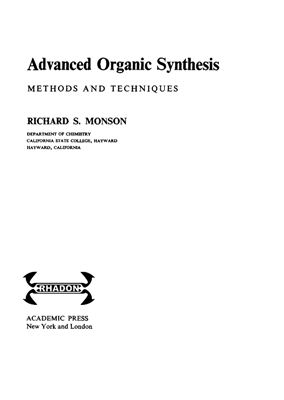ACADEMIC PRESS, 1971. – 203 p.
The purpose of this text is to provide a survey, and systematic introduction to, the mode techniques of organic synthesis for the advanced undergraduate student or the beginning graduate student. An attempt has been made to acquaint the student with a variety of laboratory techniques as well as to introduce him to chemical reagents that require deftness and care in handling. Experiments have been drawn from the standard literature of organic synthesis including suitable modifications of several of the reliable and useful preparations that have appeared in "Organic Synthesis. " Other examples have been drawn from the original literature. Where ever possible, the experiments have been adapted to the locker complement commonly found in the advanced synthesis course employing intermediate scale standard taper glassware. Special equipment for the performance of some of the syntheses would include low-pressure hydrogenation apparatus, ultraviolet lamps and reaction vessels, Dry Ice (cold finger) condensers, vacuum sublimation and distillation apparatus, and spectroscopic and chromatographic instruments.
FUNCTIONAL GROUP MODIFICATIONS
Chemical Oxidations
Hydride and Related Reductions
Dissolving Metal Reductions
Hydroboration
Catalytic Hydrogenation
The Introduction of Halogen
Miscellaneous Elimination, Substitution, and Addition Reactions
SKELETAL MODIFICATIONS
The Diels-Alder Reaction
Enamines as Intermediates
Enolate Ions as Intermediates
The Wittig Reaction
Reactions of Trialkylboranes
Carbenes as Intermediates
Ethynylation
Structural Isomerizations
Elimination, Substitution, and Addition Reactions Resulting in Carbon-Carbon Bond Formation
Miscellaneous Preparations
Appendix
1. Examples of Multistep Syntheses
Appendix
2. Sources of Organic Reagents
Appendix
3. Introduction to the Techniques of Synthesis
The purpose of this text is to provide a survey, and systematic introduction to, the mode techniques of organic synthesis for the advanced undergraduate student or the beginning graduate student. An attempt has been made to acquaint the student with a variety of laboratory techniques as well as to introduce him to chemical reagents that require deftness and care in handling. Experiments have been drawn from the standard literature of organic synthesis including suitable modifications of several of the reliable and useful preparations that have appeared in "Organic Synthesis. " Other examples have been drawn from the original literature. Where ever possible, the experiments have been adapted to the locker complement commonly found in the advanced synthesis course employing intermediate scale standard taper glassware. Special equipment for the performance of some of the syntheses would include low-pressure hydrogenation apparatus, ultraviolet lamps and reaction vessels, Dry Ice (cold finger) condensers, vacuum sublimation and distillation apparatus, and spectroscopic and chromatographic instruments.
FUNCTIONAL GROUP MODIFICATIONS
Chemical Oxidations
Hydride and Related Reductions
Dissolving Metal Reductions
Hydroboration
Catalytic Hydrogenation
The Introduction of Halogen
Miscellaneous Elimination, Substitution, and Addition Reactions
SKELETAL MODIFICATIONS
The Diels-Alder Reaction
Enamines as Intermediates
Enolate Ions as Intermediates
The Wittig Reaction
Reactions of Trialkylboranes
Carbenes as Intermediates
Ethynylation
Structural Isomerizations
Elimination, Substitution, and Addition Reactions Resulting in Carbon-Carbon Bond Formation
Miscellaneous Preparations
Appendix
1. Examples of Multistep Syntheses
Appendix
2. Sources of Organic Reagents
Appendix
3. Introduction to the Techniques of Synthesis

